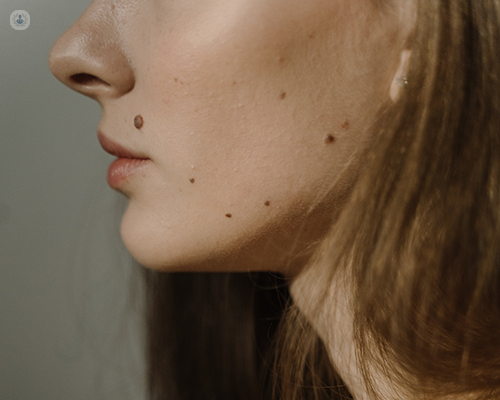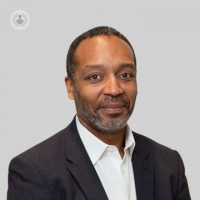Pain, swelling and numbness: Do I need salivary gland surgery?
Written by:Pain, swelling and numbness are usual symptoms of pathological processes, such as tumours or infections, that affect the salivary glands. To alleviate these symptoms, diagnose conditions and prevent aggravation of these processes, salivary gland surgery may be recommended. Mr Robert Goddard, highly revered consultant oral and maxillofacial surgeon, explains what this procedure entails and what patients can expect afterwards.

Why might patients need salivary gland surgery?
In the oral cavity (mouth) there are three pairs of major salivary glands: the parotid gland, the submandibular salivary gland and the sublingual gland on each side of the face. In addition, there are a number of tiny minor salivary glands present in the lips, inside the cheeks and the roof of the mouth. These glands can be affected by a number of pathological processes that most commonly are benign, but that in a small minority of cases, can be malignant. The chances of malignancy are very small in everyone but elderly patients or patients with risk factors, such as people who smoke, people who are heavy drinkers and people who are malnourished.
A salivary gland pathology can therefore present in different ways, depending on the cause and site of the pathology:
1. By far, the commonest cause of diseases affecting the minor gland pathology is something called a mucocoele, a mucus retention cyst. This commonly affects children and young people and presents as a clear fluid filled, intermittently recurring, painless swelling of the lip. People tend to seek treatment for this due to its unsightly appearance. Treatment options could include monitoring (especially in children when trying to avoid operations under a general anaesthetic), surgical decompression (though it often recurs) and excisional biopsy under local anaesthesia. The procedure itself usually takes less than 20 minutes from start to finish and recovery is usually uneventful, allowing the patient to resume normal social activity almost immediately.
2. The commonest cause of diseases affecting the sublingual salivary gland is something called a rannula. This is in effect a larger version of a mucocoele that presents as a clear fluid filled sac in the floor of the mouth, again, in the younger patient cohort. Again, surgical decompression can lead to recurrence. If excision of the lesion is indicated, this operation is usually done under general anaesthesia. Due to adjacent critical structures, patients can be left with a numb tongue on one side, restriction of tongue movement due to scarring and even recurrent obstruction of salivary flow from the submandibular salivary gland, needing more major surgery to remove that gland. For these reasons, the decision to operate on a rannula is taken only after careful assessment of risks versus benefits. On rare occasions, consideration may be given to injecting the sac or salivary gland with a drug to ‘dry up’ the extravasated saliva.
3. Diseases of the submandibular salivary gland often present as an intermittent swelling of the gland associated with the thought or act of eating. The obstruction is commonly due to a stone formation within the outgoing duct or within the gland itself. The swelling can be quite significant, affecting the underside of the lower jaw. When the duct is only partially obstructed, the swelling tends to reduce over time after eating food, a process which can be somewhat expedited by trying to milk the saliva out of the area. Where there is significant obstruction, the stagnant area of saliva is prone to bacterial infection with organisms located in the mouth. In such cases, patients may require a course of antibiotics. In severe cases, patients may need to be admitted for acute surgical incision and drainage of the ensuing abscess. This condition can occur at any age, although in older patients, other more serious causes of obstruction may be at play.
4. Parotid gland disease is commonly due to benign conditions. Inflammation of the gland can be due to viruses (for example, mumps) or bacteria, due to ascending infection from the mouth when there is obstruction of the parotid duct, commonly due to stone formation, plus or minus scarring around the duct orifice. Patients tend to present with facial swelling around the ear and feeling generally unwell with fever, due to the bacteria or virus present in the blood. Parotitis of this nature is more common in those who have a history of recent or recurring dehydration, as experienced by those living in temperate climates and also in the elderly. Due to the proximity of a nerve in the face that controls facial movement, surgical incision and drainage is seldom required. Patients often recover in the short term after receiving IV antibiotics during a short hospital admission.
5. Any of these salivary glands can undergo malignancy, with the commonest sites for this being sublingual and minor salivary glands. Large swellings in the parotid region, if not inflammatory in origin, are often benign pleomorphic adenomas (benign mixed tumours). These are very rare, but more common in the elderly. Due to the need for multi-disciplinary team discussions, these patients are usually managed in the NHS system and rarely operated in the private sector.
What does salivary gland surgery entail?
Mucocoeles: Chairside local anaesthetic is used, as if the patient were at the dentist. The swelling is surgically removed with a scalpel and the operation site is closed with removal stitches. The total operation time is around 20 minutes. Patients go home and are reviewed in the outpatient clinic six to eight week later, to ensure uneventful healing, to discuss the biopsy result and to assess if further treatment is indicated.
Rannula: Involves admission to hospital to have excision of the sac and the associated sublingual gland under general anaesthesia. The operation is carried out from inside the mouth with no external scarring. Patients may stay overnight to ensure no adverse swelling that could affect the airway and are usually discharged the next day. They are reviewed six to eight weeks later in the outpatient clinic to assess progress and to relay histological diagnosis to the patient.
Submandibular duct stone: The operation is usually performed under local anaesthesia, similar to the local one given at the dentist. A stitch is placed to prevent unwanted movement of the stone and an incision is made along the floor of the mouth. The stone is then delivered and a few tacking dissolvable stitches are inserted to close the wound. Patients are discharged on the same day and reviewed in clinic six to eight weeks later. Occasionally, the stone cannot be found and the procedure needs to be abandoned.
Whether the stone is found or not, there is a possibility that the resultant scarring can lead to recurrent obstructive sialadenitis (inflamed salivary gland), recurring symptoms of infection and the need for further, more invasive, surgery. Consequently, more than one follow-up appointment may be needed.
Submandibular gland sialadenitis: The operation to surgically remove the affected salivary gland is done as an inpatient procedure under general anaesthesia. The operation involves making an incision approximately three inches long in the neck under the jaw. The gland is surgically removed, taking care to minimise damage to the nerve that supplies sensation to the tongue. Patients are reviewed in the outpatient clinic approximately six to eight weeks later to discuss the histology result and to assess post-operative recovery.
This operation commonly causes damage to the nerve that moves one side of the lower lip, leading to a degree of facial asymmetry which is exaggerated when patients smile. Should this occur, facial ‘physiotherapy’ in the form of electrical muscle or nerve stimulation can help with long-term recovery of the nerve and muscle function. Alternatively, injection of a ‘muscle relaxant’ on the opposing side of the face can disguise the weakness, leading to a more symmetrical appearance. More than one follow-up appointment may therefore be necessary following this surgery.
Parotid disease: When the decision is taken that surgery is needed for parotid gland disease whether benign or malignant, the operation of choice is usually the removal of all, or part, of the parotid gland. When suspected malignant disease, such patients are managed under the NHS system. Removal of the parotid gland (parotidectomy) is done as an inpatient procedure in hospital under general anaesthesia. A cut is made just in front of the ear, extends down the face to the bottom of the ear and then bends slightly backward before it descends down the neck. A drain is often placed and so patients often need to remain in hospital overnight.
The resultant scaring is usually cosmetically pleasing, as it follows the ones used by surgeons performing a cosmetic face-lift. The operation is close to some structures that have relevance to patients. The nerve, which causes the facial muscles to move, runs within the gland and can be damaged, leading to some degree of partial, total, temporary or permanent facial paralysis. Should this occur, facial physiotherapy may help a little to restore a degree of facial symmetry. On healing, occasionally, artificial connections of nerves to skin receptors may result in an area of increased sweating and/or skin reddening when eating or thinking about food. Occasionally, there can be leaking of saliva or accumulation of saliva in the operative area. These latter symptoms can be resolved with a drug or a judicious injection just under the skin.
Due to the many potential early and late sequelae of the operation, patients are reviewed in the outpatient clinic six or eight weeks after their operation, but they may need further review appointments.
When is salivary gland surgery required?
Early surgery of this type is required to:
a. Diagnose suspicious lumps, ulcers, numbness or paralysis
b. Manage patient symptoms of painful and/or unsightly swellings
c. Prevent the progression of potentially life-threatening infections
Who is the ideal candidate for salivary gland surgery?
Like most surgeries, ideal candidates are those who are medically fit and physiologically young. Surgery in the private system is usually reserved for establishing a diagnosis only or for managing a benign disease. The major benefit of initial private referral is for the early diagnosis and for patient and clinician reassurance.
What symptoms does this operation relieve patient of?
Inflammatory sialadenitis: pain, unsightly swelling, temperature, difficulty eating or loss of function, dry mouth and anxiety of diagnosis
Malignant tumour: swelling, pain, altered sensation or numbness, facial paralysis and weight loss
What can patients expect afterwards? Are there any associated side-effects?
Local anaesthetic: swelling, bruising, bleeding, infection and scarring
General anaesthetic: nausea, vomiting, grogginess and disorientation
Surgery specific: numb tongue, duct obstruction needing further surgery, altered sensation of the skin operative area, sweating or reddening on eating food, facial paralysis, re-collection of saliva in operative area, persistent leakage of saliva from operative site and scarring
Mr Robert Goddard is a highly revered and experienced consultant oral and maxillofacial surgeon who specialises in salivary gland surgery. If you require salivary gland surgery, or simply wish to know more about salivary gland disorders, make sure to visit Mr Goddard’s Top Doctors profile today.


